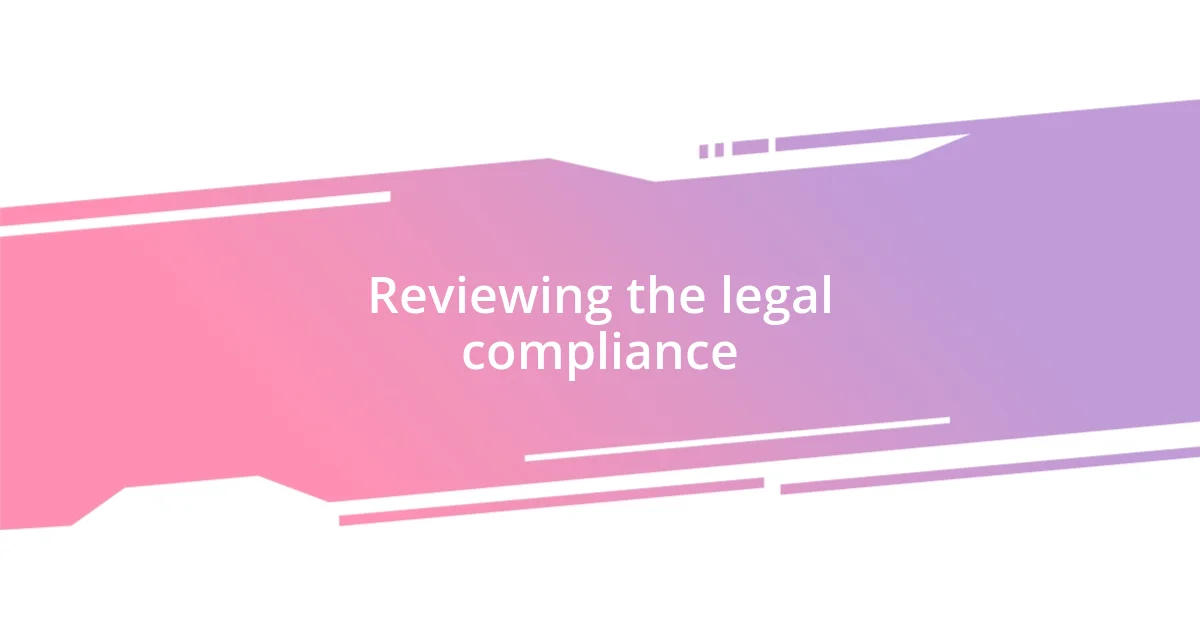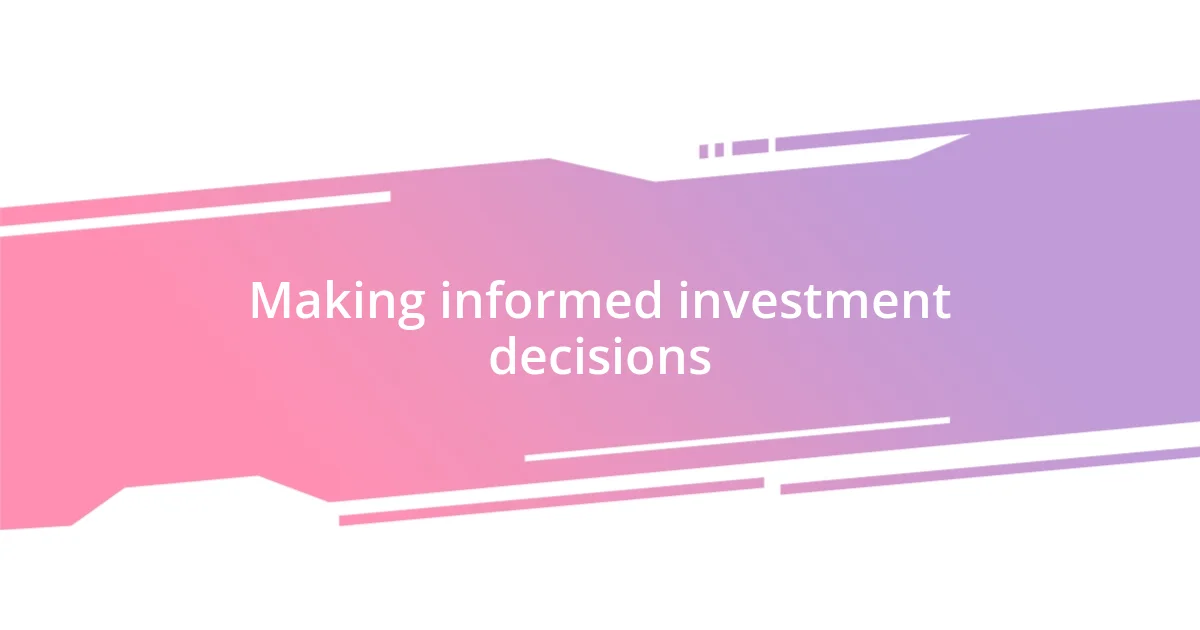Key takeaways:
- Evaluating ICO whitepapers requires focusing on clarity, transparency, and key components like problem statements, technical details, and team credentials to assess project reliability.
- A strong, committed project team with relevant experience and community engagement significantly influences the project’s success and instills investor confidence.
- Legal compliance, transparency in the legal framework, and a solid tokenomics strategy are crucial for ensuring the project’s sustainability and protecting investor interests.

Understanding ICO whitepapers
ICO whitepapers serve as the blueprint for a project, providing essential information about its purpose, technology, and goals. When I first started evaluating them, I found myself overwhelmed by the sheer amount of jargon. Have you ever felt like you were reading a foreign language? It’s so important to break down the complex terms and focus on what truly matters.
As I delved deeper into these documents, I realized that clarity and transparency are key indicators of a project’s reliability. I vividly remember stumbling upon a whitepaper that was filled with buzzwords but lacked clear explanations. It left me feeling uneasy—if the team can’t communicate their vision simply, how can they execute it? From that experience, I learned to prioritize whitepapers that offered straightforward language and solid explanations.
Finally, I’ve noticed that the team behind the project often gives insights into their credibility. Whenever I see a well-outlined team section with real names, qualifications, and LinkedIn profiles, I feel much more at ease. It’s like meeting someone for the first time; don’t you want to know who you’re dealing with? It’s those small details in whitepapers that can significantly influence my decision-making process.

Key components of ICO whitepapers
When I evaluate ICO whitepapers, I specifically look for a few critical components that truly inform me about the project. First, the problem statement is essential—this section outlines what issue the project is trying to solve. I recall reading a whitepaper that started with a compelling story about a pain point many users face. It captured my attention right away, making me invested in their solution. If the problem isn’t clear, I often wonder if the project is just trying to ride the hype wave without substance.
Here are some key components I consider:
- Project Overview: A concise summary of the project’s goals and vision.
- Token Utility: Details on how the token will be used within the ecosystem.
- Technical Details: An explanation of the technology behind the project, including any innovations.
- Roadmap: A timeline showing future development milestones and goals.
- Team Credentials: An overview of the team members and their relevant experience.
I can’t stress enough how much a clear roadmap matters. Once, I was taken by a project with lofty ambitions, but their timeline was so vague that I felt like I could have written it myself. Without concrete milestones, it’s hard to trust that a project can deliver on its promises. Each of these components provides a stronger sense of whether the ICO aligns with my investment philosophy.

Evaluating the project team
Evaluating the project team is crucial in assessing the viability of an ICO. In my experience, a strong team often signals a higher likelihood of success. When I first began this journey, I made the mistake of underestimating the importance of expertise. I remember evaluating one project where the team had backgrounds in both blockchain technology and successful startups. Seeing those credentials instilled confidence in me, much more than if their experience had only been in marketing or PR. It shows that they have the skills to navigate challenges.
Furthermore, I pay close attention to the team’s commitment to the project. If a whitepaper includes photos and brief biographies of team members alongside clear roles, it really stands out. I recall finding a project that not only listed team members but also provided insights into their previous achievements. It felt personal, almost like they were welcoming me into their vision. It’s a subtle detail, yet it demonstrates a level of transparency and accountability.
Another aspect I find valuable is the team’s public presence. Are they active on social media? Do they engage with the community? I once followed a project where the founders would regularly update their audience on progress and challenges. This openness made me feel more connected to the project and provided reassurance that they weren’t just hiding behind the whitepaper. A strong community presence can often be a telling sign of a dedicated team.
| Criteria | Importance |
|---|---|
| Background & Experience | Essential for expertise |
| Transparency | Builds trust and credibility |
| Community Engagement | Indicates commitment and accessibility |

Analyzing the project goals
When I assess project goals in an ICO whitepaper, I start by scrutinizing the clarity and specificity of their objectives. I once encountered a project that claimed to revolutionize the supply chain industry but offered vague goals. It left me feeling uneasy—how can a vision be exciting if it lacks tangible targets? A well-defined goal not only showcases ambition but also demonstrates that the team has a solid understanding of their mission and how to achieve it.
I also consider how the project’s vision resonates with real-world applications. I remember being drawn to a project that aimed to integrate renewable energy solutions into blockchain. Their goal spoke to me because it addressed both innovation and sustainability—two areas I’m passionate about. That connection made the project feel more than just a financial opportunity; it felt like a chance to be part of something meaningful. Don’t you find it easier to support initiatives that align with your values?
Lastly, I always look for how the project’s goals are structured around measurable outcomes. I learned this the hard way with a project that promised rapid adoption rates but provided no metrics to gauge success. It reminded me of a friend who loves to set ambitious goals but never tracks progress—without numbers, it’s easy to lose direction. Projects that outline key performance indicators (KPIs) demonstrate accountability and a pathway to success that gives me more confidence to invest.

Assessing tokenomics and utility
When I dive into assessing tokenomics, I focus on how the token’s economy is structured and its overall utility. I’ve seen too many projects where the token seemed to serve no purpose other than raising funds. It makes me wonder—what keeps investors interested in a token that lacks real functionality? The best projects that I’ve evaluated offer clear use cases, whether it’s for platform transactions, governance, or incentivizing behavior within the ecosystem. This clarity is essential because it justifies the token’s existence and can drive demand.
I also pay close attention to token distribution and its implications. For instance, during my evaluation of a particular ICO, I noticed that a considerable percentage of tokens were allocated to early investors and the team, leaving little for the community. That raised red flags for me—how could the platform thrive if the community was sidelined? It’s vital for the tokenomics to encourage long-term investment rather than short-term speculation. A thoughtful distribution strategy builds trust and ensures the ecosystem remains robust.
Another crucial element is the potential for appreciation of value over time. I recall a project where the teams detailed a clear plan for token scarcity through mechanisms like buybacks or burn events. This kind of foresight reassured me that they were not just looking to capitalize quickly but were committed to sustainability and growth. Don’t you think it’s motivating to back a project that shows a genuine strategy for long-term value creation? The interplay of tokenomics and utility can significantly influence my confidence in a project, guiding my investment decisions with greater clarity.

Reviewing the legal compliance
When I review the legal compliance of an ICO, the first thing I do is examine their adherence to local regulations. There was a time when I came across a project that boldly claimed it was operating without any legal oversight. It made me pause—how could they think they could navigate such a treacherous terrain? Without compliance, the project not only risks fines but also potential shutdown, which would leave investors in a lurch. It’s like deciding to swim in uncharted waters without a life jacket; the risks far outweigh any potential reward.
I also pay attention to disclosures and transparency. In my experience, a comprehensive whitepaper that clearly outlines the legal framework can be a huge red flag indicator. Once, I evaluated a project that included a detailed section covering their registration, legal opinions, and how they planned to comply with securities laws. This openness instilled a sense of trust for me—it’s as if they were saying, “We have nothing to hide; join us on this journey!” Isn’t it reassuring to know that a project is committed to playing by the rules?
Additionally, I consider the quality of the legal team behind the project. A while back, I invested in an ICO where the legal advisors were well-known industry veterans. Their prior work gave me confidence that the project was well-structured and safeguarded against legal pitfalls. I often ask myself: how can a project thrive if it lacks strong legal support? A solid legal foundation can be the difference between success and failure, and I firmly believe that no project can truly flourish without a comprehensive legal strategy guiding its path.

Making informed investment decisions
When considering my investment decisions, I’ve discovered that thorough research is crucial. One time, I came across an ICO that seemed promising at first glance, but a deeper dive revealed inconsistencies in their roadmap. It got me thinking—how often do we overlook red flags for the sake of excitement? I’ve learned that patience in the evaluation stage can save me from potential pitfalls down the line.
I also find it essential to reflect on the team’s credibility. For instance, I once invested in a project because the founders had extensive experience in blockchain technology. Their background gave me a sense of security, almost like knowing my ship was captained by seasoned sailors. Wouldn’t you agree that having knowledgeable people at the helm can significantly boost your confidence in a venture? Trusting the right team makes me feel more secure in my investment choices.
Ultimately, I’ve realized that the community surrounding an ICO plays a pivotal role in its success. During my research, I participated in forums and discussions and found that a project with an engaged and enthusiastic community is often more likely to succeed. Reflecting on my experiences, it’s clear—supportive ecosystems foster resilience. So, are you ready to look beyond the numbers and explore the human element that can make or break an investment?














